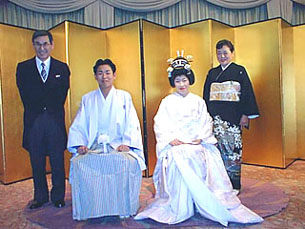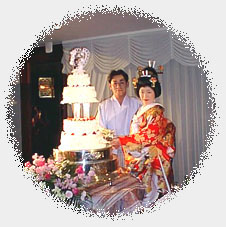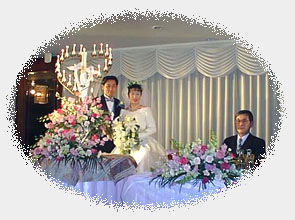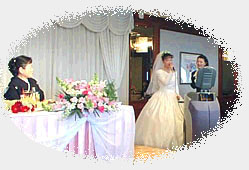A week had not passed since
the wedding party in Osaka, when I went to another wedding party. Though, this is the third wedding party on my site, this had its particularities. It followed, first of all, the traditional wedding party style with a matchmaker couple but also adopted a lot of of new ideas.

The bride and bridegroom sit in front of golden screens attended by the matchmaker couple and pose for cameras.
The wedding took place in a facility near JR Nakano station which accommodates many cultural and sports facilities such as theaters and bowling lanes as well as party rooms.

While party guests were gradually gathering, the wedding ceremony was going on in a private shrine built within the building for the purpose of wedding. The participants of the ceremony are usually limited to the relatives of the marrying couple and the matchmaker couple. In this facility, however, other guests could watch the ceremony in a TV display equipped in the waiting room.
When the wedding ceremony ended, the newly married couple appeared at the entrance of the party room and posed for cameras. The hair style and dress of the bride are typically traditional. Her hair style - of course wig ! - is called "
taka-shimada" (also check the case of Osaka. The bride there has also taka-shimada) and the dress "
uchikake" (most formal "kimono"). The white dress is called "
shiro-muku" and thought to express the purity of the bride and at the same time her resolution not coming back alive to the parents' house. White color is the color of celebration, but at the same time the color of death and funeral. The bride by then took off "
tsuno-kakushi"
(*) which you can see, though not clear, on the TV display.
(*) "Tsuno-kakushi" means "horn hider". This white cloth was originally used by rich women to protect their hair from dust. In Meiji era it came to be used for wedding with the implication that the bride should not show her "horn" - symbol of jealousy and anger.
The bridegroom also wore formal kimono. The jacket is called "
mon-tsuki" and the family crest
(**) is dyed on five places: two on the breasts, one on the back and the two on the sleeves. The pants is called "
hakama".
 (**)Besides Europe crest is developed the most in Japan. Every family has its own crest. Different from European crests, Japanese crests are monochrome and their motives are usually plants. The crest of my family is ivy (see the image right.).
(**)Besides Europe crest is developed the most in Japan. Every family has its own crest. Different from European crests, Japanese crests are monochrome and their motives are usually plants. The crest of my family is ivy (see the image right.).
During the course of the wedding party, brides usually change dresses once or twice. When all guests took seats, the bride and bridegroom entered the room escorted by the matchmaker couple. The bride wore this time a colorful "uchikake".
As usual, the matchmaker first reported on the wedding ceremony which had just taken place and introduced the freshly married couple to the guests. Following the address of the matchmaker, the main guest gave a speech. Then, the bride and bridegroom jointly cut the wedding cake. The cake was a real one and distributed later to the guests as dessert.
On the table, guests found handmade cards prepared by the bride and bridegroom. A "
purikura" (abbreviation of "print club" in Japanese) photo of the couple was stuck on the card and the words of thanks of the couple were handwritten with their signatures. I would show you the actual size purikura photo here left.

The handmade card is a relatively new idea, which gives the wedding party sort of personal touch. Another idea, with the same intention but commercially arranged, was this small white wine bottle on whose label the name of a guest was printed. Also what appeared very new to me was a small ceremony of presenting bouquets by a small girl and a boy to the bride and bridegroom. It might be stimulated by bridesmaids in the European style wedding, I presume.

|
 Posing for cameras after candle service. The main candle was set up, in the same way as the wedding cake, next to the main table. The main table was as usual a square shaped one and the bride and bridegroom were sat between the matchmaker couple. Here on the right side of the photo you see the matchmaker sitting at the table. |
In Tokyo people pay much attention to the quality of meal and invest a lot. However, the female guests are usually more interested in dresses of the bride and generally speaking young guests are more curious about other guests of the opposite sex :-) After the wedding party and the older guests and relatives have left, young people usually get together and hold the second session of the party in a more relaxed atmosphere. The party often continues till the next morning :-) and the new couple has to go to the honeymoon directly from their party room.
I don't want to follow the proceedings of the party, because it was more or less the same as those I previously reported. One thing I should mention here is that the small candles arranged in a heart shape and surrounding the main candle were genuine candles and not small electric lamps which were used in Osaka. As for songs, the number of people or groups of people who sang songs were four. One of them sang a Capella. So, it was not "karaoke party" :-) However, the bride as an exceptional case sang together with her friend (See the photo below right). All in all, I might say, people in Osaka like gaudy things and guests enjoy wedding party as their own entertainment. On the other hand, people in Tokyo want to have a smart party and guests are treated as guests.
The bride sang together with her friend. The older woman left is the wife of the matchmaker. Between her and her husband (see the photo above), there are the seats for the bride and bridegroom. |


 (**)Besides Europe crest is developed the most in Japan. Every family has its own crest. Different from European crests, Japanese crests are monochrome and their motives are usually plants. The crest of my family is ivy (see the image right.).
(**)Besides Europe crest is developed the most in Japan. Every family has its own crest. Different from European crests, Japanese crests are monochrome and their motives are usually plants. The crest of my family is ivy (see the image right.). The handmade card is a relatively new idea, which gives the wedding party sort of personal touch. Another idea, with the same intention but commercially arranged, was this small white wine bottle on whose label the name of a guest was printed. Also what appeared very new to me was a small ceremony of presenting bouquets by a small girl and a boy to the bride and bridegroom. It might be stimulated by bridesmaids in the European style wedding, I presume.
The handmade card is a relatively new idea, which gives the wedding party sort of personal touch. Another idea, with the same intention but commercially arranged, was this small white wine bottle on whose label the name of a guest was printed. Also what appeared very new to me was a small ceremony of presenting bouquets by a small girl and a boy to the bride and bridegroom. It might be stimulated by bridesmaids in the European style wedding, I presume.


